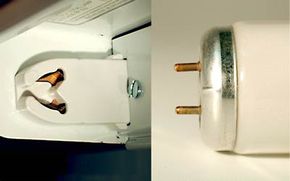Light Right Away
Today, the most popular fluorescent lamp design is the rapid start lamp. This design works on the same basic principle as the traditional starter lamp, but it doesn't have a starter switch. Instead, the lamp's ballast constantly channels current through both electrodes. This current flow is configured so that there is a charge difference between the two electrodes, establishing a voltage across the tube.
When the fluorescent light is turned on, both electrode filaments heat up very quickly, boiling off electrons, which ionize the gas in the tube. Once the gas is ionized, the voltage difference between the electrodes establishes an electrical arc. The flowing charged particles (red) excite the mercury atoms (silver), triggering the illumination process.
Advertisement
An alternative method, used in instant-start fluorescent lamps, is to apply a very high initial voltage to the electrodes. This high voltage creates a corona discharge. Essentially, an excess of electrons on the electrode surface forces some electrons into the gas. These free electrons ionize the gas, and almost instantly the voltage difference between the electrodes establishes an electrical arc.
No matter how the starting mechanism is configured, the end result is the same: a flow of electrical current through an ionized gas. This sort of gas discharge has a peculiar and problematic quality: If the current isn't carefully controlled, it will continually increase, and possibly explode the light fixture. In the next section, we'll find out why this is and see how a fluorescent lamp keeps things running smoothly.
